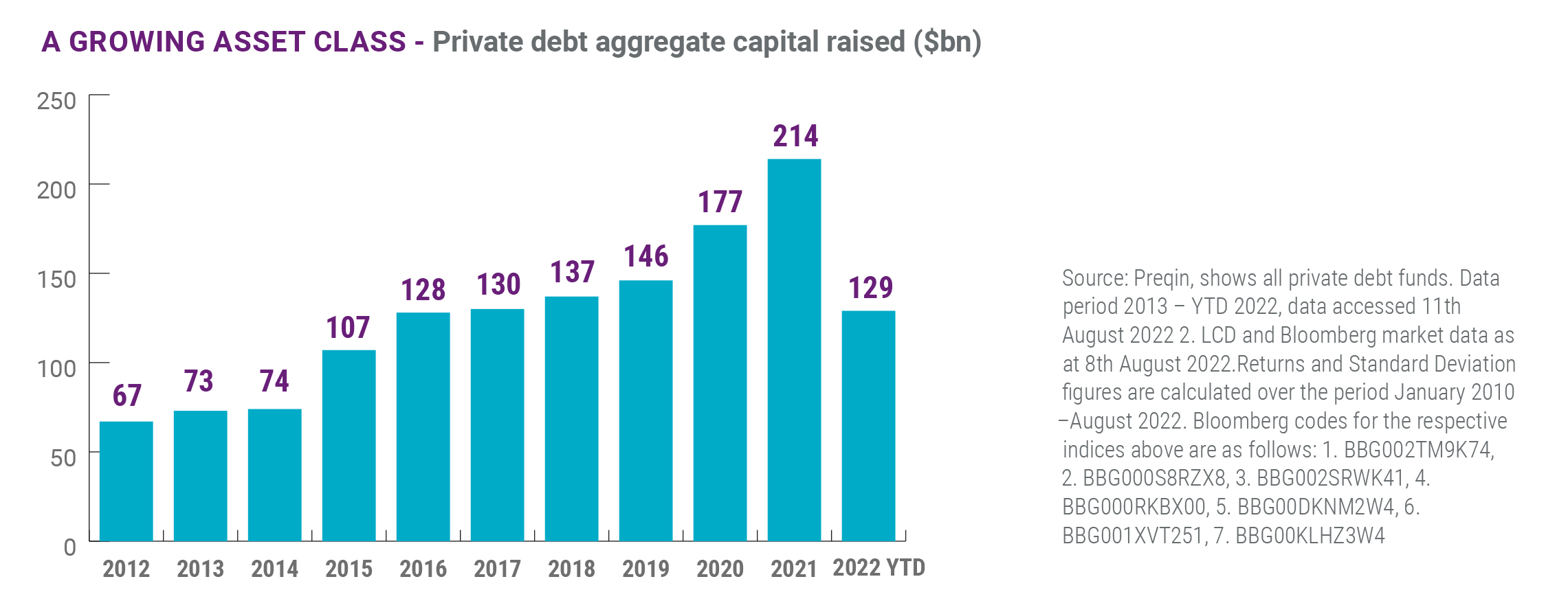The Democratisation of Private Debt Investing
Highlights
- A low-cost, accessible approach to private debt, with liquidity, has enjoyed a successful first year
- The original 50:50 target asset allocation split between liquid credit and private debt instruments has moved to 60:40 in favour of private debt,
- Initial interest from DC and DB pension schemes has widened to include discretionary wealth managers and private banks.
Investors have seen strong performance relative to bond markets, and have access to liquidity meaning redemptions can be made more easily and often than pure private debt vehicles.
The partnership between MV Credit and Loomis, Sayles & Company, both affiliates of Natixis Investment Managers, is working so smoothly that it has been possibly to increase the proportion of private debt in the portfolio, further reinforcing its defensive properties and increasing the attractiveness of the approach to institutional investors.
Investor demand for accessible private debt
The approach was conceived as a response to demands from DC schemes and smaller DB schemes for access to the same illiquid assets that have hitherto been the preserve of large DB schemes, endowments and foundations.
There are a number of impediments to smaller institutions employing illiquid asset classes:
First, illiquid and often closed-end fund structures do not meet regulatory requirements for many investor types, including the DC market. Second, the large minimum commitments demanded by managers of illiquid assets reduce portfolio diversification for smaller investors. Third, fees for private assets are relatively high and usually contain a sizeable performance fee. Fourth, it is a complex asset class to analyse, and often beyond the due diligence skills of smaller institutions. This imposes governance costs. Last, many investors worry about locking up their money for long periods.
So the two Natixis Investment Managers affiliates joined forces to build a strategy which provides a relatively low-cost, accessible exposure to private debt. At launch, half of the assets were allocated to European private debt, while the other half was invested in liquid multi-asset credit portfolios, creating considerably more liquidity than pure private debt funds.
For members of DC schemes who choose low-risk default strategies, and for smaller DB schemes, the strategy can enhance returns from fixed income allocations while keeping volatility low.
Unlike allocations to pureplay private debt strategies, the MV Credit/Loomis Sayles approach puts investors’ capital to work from day one. Initially, investor money is allocated to the liquid Loomis Sayles portfolio, where it can be deployed rapidly. In the meantime, MV Credit identifies private market investment opportunities to enhance strategy returns. As these opportunities materialize, Loomis Sayles divests some of the assets and the proceeds are used to buy private debt managed by MV Credit.
The process is repeated over the next 12-18 months until all of an investor’s assets reach the target allocation.
Increasing the illiquid allocation
In fact, the proposition has worked so well that the target allocation has been improved to 60:40 in favour of private debt. “We completed 50 private transactions in just 12 months, much quicker than we envisaged,” says Murtaza Merchant, Partner at MV Credit. Given the pace of transactions and the affiliates’ assessment that liquidity for investors would not be materially impaired, the target allocation was shifted to 60:40 in favour of private debt.
In the current environment, this shift is advantageous. One of benefits of private assets is their floating rates, which mitigate the current risks associated with fast-rising interest rate regimes around the globe.
The seed investor was happy with the way the partnership was working but wanted more private exposure. After careful consideration, MV Credit and Loomis Sayles were willing to accommodate.
Merchant says: “People asked at the start if two independent investment managers can work together. We have shown it can work. Every time we have needed to draw funds from Loomis to complete a private debt transaction, there has been a smooth transition.”
A key aspect of the partnership is that both firms focus on what they do best and keep the design of their strategies close to their flagship strategies. “We can now demonstrate that the plumbing, operations, and all aspects of the collaboration work effectively,” says Alex Thompson, investment director at Loomis Sayles.
“It is also very important that there is a clear asset allocation framework and that neither Loomis nor MV second-guess each other’s investment decisions,” Thompson adds.
The lines of communication between the two firms also extend to the commonality of their approaches to ESG, which is part of the fundamental credit analyses of each firm.
Market turbulence favours private assets
Private debt has been largely unaffected by the volatility in public markets during 2022. “We invest in diverse industries and geographies, with a particular focus on defensive industries such as healthcare and IT, which are more resilient in tough times,” says Merchant.
The loans are floating rate so, unlike public market fixed rate bonds, the private debt portfolio actually gets an uplift when rates rise. At the same, companies in the portfolio face rising costs of financing so the MV Credit team needs to ensure debt ratios are sustainable. Managers who have managed through cycles, and particularly through the Great Financial Crisis, are likely to be better at spotting the industries and companies that are best equipped to withstand debt pressures.
The market turbulence has created new opportunities for private debt investors, with lending terms moving in favour of lenders, rather than borrowers.
Furthermore, public market volatility has led to more private issuance. Typically during crises, public markets freeze and some bank-led transactions are no longer viable. “As a result, opportunities open up in private markets and players like us can step in and lend to good-quality companies,” says Merchant. “Our long-standing relationships with private equity sponsors help us source these kinds of deals,” he adds.

Deep opportunity set key to public debt markets
The liquid part of portfolio, managed by Loomis Sayles, is more flexible and can adjust rapidly to an evolving macro environment.
As rates rose from early 2022 onwards Loomis Sayles lowered its weightings to the more interest rate sensitive asset classes within its opportunity set and increased allocations to high yield and bank loans, which are more resilient in the initial stages of a rising rate environment.
This strategy was maintained until mid-2022 when the market narrative shifted from worries about inflation to concerns about growth. That is, the cost of central banks hiking rates was a hit to the global economy’s growth potential. In that scenario, company balance sheets are under great scrutiny and default fears begin to come into focus. “If defaults are likely to rise we will naturally seek high-quality bonds,” says Thompson.
It is important to have a global opportunity set across the entire capital structure and all sectors to implement this flexible approach.
A global opportunity set allows bond investors to take a view, for instance, on the US versus Europe or Asia versus the US. For example, Loomis Sayles sees the US as a relatively self-sufficient economy less impacted by the energy crisis currently engulfing Europe, yet valuations in Europe are enticing. The US bond market is also bigger and deeper than Europe. “From a fundamental standpoint, we are more positive on the US at this time,” says Thompson. “We also like emerging markets, but we have stepped back given recent volatility and will move back in when the time is right given valuations look great.”
Even in the US, Loomis is highly selective, avoiding the highest-risk credits and playing in the space between investment grade and high yield, where it routinely sees mispricing opportunities. In particular, it sees value in CLOs, which offer good value relative to corporates. Securitised loans and bank loans also provide useful diversification.
Hitting the sweet spot
The public-private approach of MV Credit and Loomis Sayles has demonstrated it can hit the sweet spot between outperformance and a robust liquidity profile. While it will never capture all of the upside when public bond markets surge, it has already shown it can offer substantial downside protection when bond markets are struggling.
As a consequence, the initial interest from DC and DB schemes has widened to include discretionary wealth managers and private bankers. “This is now a go-to offering for any investor with a medium- to long-term investment horizon and interest in accessing private debt markets,” says Thompson.
Published in February 2023
An affiliate of Natixis Investment Managers
Registered Number : OC397214
Authorised and Regulated by the Financial Conduct Authority (FCA)
45 Old Bond Street, London, W1S 4QT
www.mvcredit.com
Loomis, Sayles & Company, L.P.
A subsidiary of Natixis Investment Managers
Investment adviser registered with the U.S. Securities and Exchange Commission(IARD No. 105377)
One Financial Center,
Boston, MA 02111, USA
www.loomissayles.com
Natixis Investment Managers
RCS Paris 453 952 681
Share Capital: €178 251 690
43 avenue Pierre Mendès France
75013 Paris
www.im.natixis.com
This communication is for information only and is intended for investment service providers or other Professional Clients. The analyses and opinions referenced herein represent the subjective views of the author as referenced unless stated otherwise and are subject to change. There can be no assurance that developments will transpire as may be forecasted in this material.
Copyright © 2023 Natixis Investment Managers S.A. – All rights reserved





 Private Debt and Liquidity Finally Meet
Private Debt and Liquidity Finally Meet
 The Five Myths of “Illiquids”
The Five Myths of “Illiquids”
 The Folly of the Fetish for Liquidity
The Folly of the Fetish for Liquidity